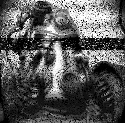|
HalloKitty posted:Blame whoever thought it was a good idea to flip PCI slots so boards could be loaded with both ISA (cool and correct way up) and PCI but have them overlap each other, so you could use either one and occupy the same external slot.. 20 (30?) years ago I got it. PCI and PCI-X were new standards designed to free us from the shackles of ISA. But there had to be a transition period. Now for PCI-E they've done the same thing but instead of making it temporary they just said gently caress it let's put several hundred watts of power in the wrong orientation forever. It also kinda made sense when desktops were the norm, not mini towers. Heat could flow "up". Now all of the innovative stuff is stuffing laptops into desktops through mini pc's and calling it good enough since enthusiasts will buy literally anything.
|
|
|
|

|
| # ? May 26, 2024 21:28 |
BobHoward posted:no, I read the threads that I read, apparently we have some overlap, and sometimes you make goofy posts that are fun to dunk on a bit What's a layer violating about WireGuard? It's "just" a UDP based VTI, is it not? I believe even Linux is getting OpenCrypto support, though I'm not up on the details.
|
|
|
|
|
The stupid reason why PCIe cards are upsidedown is because motherboard/case makers wanted to share the slot/bracket locations between ISA (component side up) and PCI (component side down because it was the new kid) slots. And since ATX is still used it just keeps on keepin on! Pour one out for BTX.
|
|
|
|
I don't think ATX and its derivatives will be unseated until a theoretical mainstream switch to a new architecture, with a clean slate design. But the odds of that happening are slim to none, odds are we'll simply get ATX boards with ARM, RISC-V etc. CPUs and never fix our silly upside-down expansion cards.
|
|
|
|
I know why, I'm saying it's stupid.
|
|
|
|
I'm surprised no GPU manufacturer has said "gently caress it" and put out a mirrored card that puts everything on the 'wrong' side.
|
|
|
|
IOwnCalculus posted:I'm surprised no GPU manufacturer has said "gently caress it" and put out a mirrored card that puts everything on the 'wrong' side.  Or a case/bracket that lets you flip it. Or a case/bracket that lets you flip it.
|
|
|
|
H110Hawk posted:
Now that you mention this I swear there have been some SFF-style cases that have a x16 riser card/cable and mount the GPU parallel to the motherboard. Give me that but in a case that will fit at least a microATX motherboard and a gigantic air cooler.
|
|
|
|
IOwnCalculus posted:Now that you mention this I swear there have been some SFF-style cases that have a x16 riser card/cable and mount the GPU parallel to the motherboard. Give me that but in a case that will fit at least a microATX motherboard and a gigantic air cooler. There are pcie ribbon cables that let you mount gpus pretty much any which way you want! Lots of cases have screw mount points for these as well. Just make sure it isnít a cheap lovely one like the nzxt one that could cause a fire due to shorting. (Gamers nexus had a big thing on this)
|
|
|
|
And as previously mentioned, inverted ATX cases are also a thing. If I were to build a new PC*, I would go for a microATX board in an inverted minitower case. *Which I'm not, because  shortages and price gouging. shortages and price gouging.
|
|
|
|
BlankSystemDaemon posted:Assuming it's implemented properly, WireGuard should be using the exact same ChaCha20+Poly1305 implementation as IPsec, provided through crypto(9) on FreeBSD, and opencrypt(9) on NetBSD and OpenBSD, as the entire point of OpenCrypto is to provide an abstraction layer so that consumers don't have to implement their own crypto primitives. See https://www.wireguard.com/papers/wireguard.pdf. Donenfeld describes the layering violation (from a Linux perspective), and the motivations for that and other decisions which diverge from existing VPNs. On the crypto, would it surprise you that Donenfeld appears to be very particular about it and, even on his original Linux implementation, wanted to use his own simpler crypto library rather than the traditional Linux equivalent of crypto/opencrypt? https://lwn.net/Articles/802376/ He does have some points, and he's not a crypto cowboy, he actually put in the work to do formal verification on his code: https://lwn.net/Articles/770750/ The entire theme I get from reading up on his work is that he's very invested in handcrafting a highly optimized minimalist implementation of everything related to WireGuard. This opens up the door to formal verification, and he's taken advantage of it (not just for the crypto code, but apparently also some/all? of the networking, at least in the linux version).
|
|
|
|
Got 4x 18TB drives coming this weekend, time to start upgrading these 8tb ones.
|
|
|
|
IOwnCalculus posted:I'm surprised no GPU manufacturer has said "gently caress it" and put out a mirrored card that puts everything on the 'wrong' side. Asus made a 6600gt like that and it went about as well as you can imagine
|
|
|
BobHoward posted:See https://www.wireguard.com/papers/wireguard.pdf. Donenfeld describes the layering violation (from a Linux perspective), and the motivations for that and other decisions which diverge from existing VPNs. Formal verification is absolutely a laudible goal, but it doesn't really get you very far unless everything else from the bottom-up has been formally verified - so unless you're running WireGuard on seL4 on RISC-V (and good luck with that, because it's not Unix-like let alone POSIX compatible), I'm not sure how much good it'll do you. Even then, formal verification only works if you do it programmatically and automatically for every single change (ie. as part of a testing framework, whether that be through Kyau or similar, CI tooling, or a pre-commit hook), so it slows down development a lot. Also, the implementations of IPsec in Linux, FreeBSD, OpenBSD and NetBSD have all been independently verified multiple times by different people. And now for something completely different: I think everyone's seen the announcement? I think we can all agree that Scuttle_SE is a honorary packrat. Oh, and in case anyone's interested, there's a FreeBSD Developer Summit happening today and tomorrow (it started yesterday, but I forgot to mention it). Here's todays stream: https://www.youtube.com/watch?v=sE7gSlRAvsc Yesterdays stream was great (especially the Hallway track between sessions, although unfortunately that's only for committers and contributors who've been invited), and it ended with Kirk McKusick telling stories about the TCP/IP wars as well as the BSDi/UCB v USL lawsuit. He even confirmed what I thought was an apocraphyl story about a VMS tape falling off the back of a truck at CSRG.
|
|
|
|
|
BlankSystemDaemon posted:And now for something completely different: I think everyone's seen the announcement? Yeah that's crazy. 800+GB of jpgs isn't that much these days, but 10 years ago it would have been a pretty next level archiving for an individual.
|
|
|
|
Takes No Damage posted:Yeah that's crazy. 800+GB of jpgs isn't that much these days, but 10 years ago it would have been a pretty next level archiving for an individual. Would it have been though? I mean on the first page of this thread from 2008 we have multiple people discussing 1-2 TB setups with the sub-1TB stuff being mostly cheap builds.. I don't recall when in 2011 the WaffleImages shutdown was, but page 100 is from August of that year and has discussions of 2 and 3TB disks as normal with multiple people being in the deep double digits on their total capacity. Not to discount the effort of actually doing it and hanging on for this long, since apparently no one else did, it just seems weird to call it "next level archiving" if the entire dataset could fit on a single midrange retail USB hard drive of the time.
|
|
|
|
wolrah posted:Not to discount the effort of actually doing it and hanging on for this long, since apparently no one else did, it just seems weird to call it "next level archiving" if the entire dataset could fit on a single midrange retail USB hard drive of the time. It's next level archiving because no one else did it. He even set up a torrent and website to let people see the images.
|
|
|
|
Inept posted:It's next level archiving because no one else did it. He even set up a torrent and website to let people see the images. Again though, I do not in any way want to take away from the value of not only having actually done it, but having kept it all this time. If I had been the custodian of said data I'd have lost half of it in my first LVM failure, lost another third of what remained from not learning my lesson the second time around, and corrupted about 10% of the rest from using btrfs wrong on my third setup. And that's if I hadn't deleted it at some point to make space for whatever else I wanted to download while tight on funds. Keeping all that "useless" content around was a wonderful act and it's a great thing that we can now browse an era of threads mostly intact again. The amount of data is not the impressive part is all I'm saying.
|
|
|
|
I've got a WD Elements External HDD connected to my MacBook Air and the spin down on it is super aggressive. It starts to spin down after 2-3 minutes of inactivity. I have 'put hard disks to sleep when possible' unchecked in sys prefs. It's kind of a pain when finder hangs for 5-10s every time I access it, and I don't imagine constant spin-ups and spin-downs can be great for it either. I did some quick googling and the only thing I found was a message board post from 10+ years ago where the solution was to run a touch script every few minutes to keep the disk awake, and that the aggressive spin-down was built into the firmware. Was hoping maybe someone knew of a 'better' solution that had been developed in the last decade.
|
|
|
|
wolrah posted:The amount of data is not the impressive part is all I'm saying. That's fair, it didn't come across clearly in my post but by the word 'archiving' I meant the process of maintaining the data all this time to keep it in a readable state. I probably had a few TB in my desktop at the time as well, but I wouldn't have been in any position to dedicate a giant chunk of one to millions of Advice Pet image macros, and even if I had I surely would have lost it by now for reasons similar to your own self-speculation. irpoweroutlet posted:I've got a WD Elements External HDD connected to my MacBook Air and the spin down on it is super aggressive. It starts to spin down after 2-3 minutes of inactivity. I have 'put hard disks to sleep when possible' unchecked in sys prefs. It's kind of a pain when finder hangs for 5-10s every time I access it, and I don't imagine constant spin-ups and spin-downs can be great for it either. I did some quick googling and the only thing I found was a message board post from 10+ years ago where the solution was to run a touch script every few minutes to keep the disk awake, and that the aggressive spin-down was built into the firmware. Was hoping maybe someone knew of a 'better' solution that had been developed in the last decade. When I was shucking a bunch of WD Elements for my NAS pool, I ran into the same problem when trying to run long SMART tests on them, apparently that didn't count as edit: And yeah it does say 326GB in the announcement, not sure where I got 800 from. I guess this is how it starts... Takes No Damage fucked around with this message at 22:59 on Jun 10, 2021 |
|
|
|
Astryl posted:Got 4x 18TB drives coming this weekend, time to start upgrading these 8tb ones. I've been scanning hard drive prices for a similar upgrade. What did you end up buying? El Mero Mero fucked around with this message at 23:05 on Jun 10, 2021 |
|
|
|
El Mero Mero posted:I've been scanning hard drive prices for a similar upgrade. What did you end up buying? I plan on shucking WD Elements.
|
|
|
|
Is it really worth running SMART on such massive disks. I just use them. No problems with about 20 HDDs ranging from 3 to 12 TB in the past 6 years.
|
|
|
|
Smashing Link posted:Is it really worth running SMART on such massive disks. I just use them. No problems with about 20 HDDs ranging from 3 to 12 TB in the past 6 years. It can let you know about disk failure ahead of time, so yeah, I think so.
|
|
|
|
Also there's no time easier than "before you've already put them in the array" to exchange a dead drive.
|
|
|
|
SMART is already there, it's built into every disk and every OS supports it. Enabling it and setting it up for email alerts takes minutes, so I don't see a lot of reasons not to. It doesn't catch every error or prevent every disk failure, but it's a useful tool.
|
|
|
|
S.M.A.R.T can tell you if a disk might go bad in the future, which lets you plan for it if you chart the values on graphs and have alerts that tell you about a sufficient change in the raw values of attributes. ZFS can tell you when a disk has silently gone bad, as anyone who's operated a sufficiently big fleet of disks with ZFS will have experienced.
|
|
|
|
|
Ahrens is presenting about his RAIDz expansion work right now: https://www.youtube.com/watch?v=3SUKJye54aI
|
|
|
|
|
KozmoNaut posted:It doesn't catch every error or prevent every disk failure, but it's a useful tool. edit: https://static.googleusercontent.com/media/research.google.com/en//archive/disk_failures.pdf Four parameters matter according to Google: - Scan Errors - Reallocated Sectors - Offline Reallocations - Probational Sectors They consider the critical threshold on these to be 1 because the odds of failure go up significantly, but it's not as much of a guaranteed death sentence as I recalled. I still probably wouldn't trust a drive like that longer than I had to. And the false negative rate was slightly over 50%, so you are definitely not guaranteed to get a warning. wolrah fucked around with this message at 19:06 on Jun 11, 2021 |
|
|
|
Smashing Link posted:Is it really worth running SMART on such massive disks. I just use them. No problems with about 20 HDDs ranging from 3 to 12 TB in the past 6 years. Seconding what everyone else said, I always run an extended test on them before shucking/using. Since I have been using WD externals, I'd rather find any early issues before I murder the enclosure.
|
|
|
|
Moey posted:Seconding what everyone else said, I always run an extended test on them before shucking/using. Since I have been using WD externals, I'd rather find any early issues before I murder the enclosure. Was about to post this as my main reason. If they were just a stack of bare drives then maybe just throw them in and test the whole pool later, but I wanted at least some assurance the drives were good before going through the hassle of shucking them, then maybe having to un-shuck them to return if one did end up throwing errors right away. I was doing it all through a RaspberryPi on my desk at work anyway, so I'd start the test sometime in the afternoon and it would be just finishing up when I came in the next morning.
|
|
|
|
Takes No Damage posted:Was about to post this as my main reason. If they were just a stack of bare drives then maybe just throw them in and test the whole pool later, but I wanted at least some assurance the drives were good before going through the hassle of shucking them, then maybe having to un-shuck them to return if one did end up throwing errors right away. I was doing it all through a RaspberryPi on my desk at work anyway, so I'd start the test sometime in the afternoon and it would be just finishing up when I came in the next morning. I am too lazy to do that but then I keep a lot of backups.
|
|
|
|
Moey posted:Seconding what everyone else said, I always run an extended test on them before shucking/using. Since I have been using WD externals, I'd rather find any early issues before I murder the enclosure. Best time to do it. I run an extended SMART, and since I'm using Unraid, run two or three preclears on it so as to have it read/write some TBs worth. If it dies during that, it was always going to die early.
|
|
|
|
Finally, everything is right with OpenZFS again.
|
|
|
|
|
So...someone mentioned that I was mentioned in here as the lunatic who saved all those Waffle-images... And, yeah...I admit...I'm a datahoarder... The waffleimages wasn't that big of a deal actually. I just kept my mirror going when all the other died off, then I put up randomwaffle.gbs.fm when I was bored one day and...yeah... that's about it.. Oh, and the waffle-images is just a teeny tiny part of my obsessive archiving of digital nonsense throughout the years...
|
|
|
|
Scuttle_SE posted:Oh, and the waffle-images is just a teeny tiny part of my obsessive archiving of digital nonsense throughout the years... So how much data are we talking here?
|
|
|
|
Yeah cmon, can't leave us hanging like that. This is one of the few places where people won't think your some obsessive weirdo backing up this stuff!
|
|
|
|
Rooted Vegetable posted:So how much data are we talking here? Not that much...maybe 150-200TB
|
|
|
|
Scuttle_SE posted:Not that much...maybe 150-200TB What hardware and software do you use
|
|
|
|

|
| # ? May 26, 2024 21:28 |
Mega Comrade posted:Yeah cmon, can't leave us hanging like that. This is one of the few places where people won't think your some obsessive weirdo backing up this stuff!
|
|
|
|

































